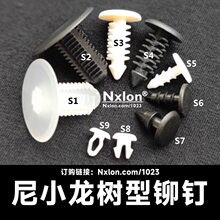Flat Head Rivet
©Nxlon.com D/T:

Structural Features of the Flat Head Rivet
Head Shape: The head is flat, usually circular or oval. Compared with the flat round head rivet, its top is flatter and has almost no curvature. This design enables the rivet to remain flush with the connected surface after riveting, providing a smooth appearance.
Shank Structure: Generally, it is a solid cylindrical shank, similar to the shanks of other rivets. The diameter and length of the shank have various specifications to meet different connection requirements. Its surface is required to be smooth to ensure that it can be smoothly inserted into the hole of the connected part and fit well with the hole wall.
Material Selection of the Flat Head Rivet
Carbon Steel: It has relatively high strength and hardness and can withstand large tensile and shear forces. It is suitable for general industrial fields, such as construction, machinery manufacturing, and other occasions with high requirements for connection strength. The cost is relatively low, but its corrosion resistance is not good, and anti-corrosion treatment is required in harsh environments.
Stainless Steel: It has excellent corrosion resistance and oxidation resistance and can maintain good performance in corrosive environments such as humidity, acids, and alkalis. It is often used in industries with strict requirements for corrosion resistance, such as food processing, chemical engineering, and medical devices. Although the cost is relatively high, it can ensure that the rivet will not be corroded during long-term use and maintain the reliability of the connection.
Aluminum Alloy: It is light in weight and has a certain degree of corrosion resistance, and is widely used in fields such as aerospace and electronic equipment manufacturing. These fields have high requirements for weight reduction. The flat head rivets made of aluminum alloy can effectively reduce the product weight while meeting the connection strength requirements.
Manufacturing Process of the Flat Head Rivet
Forging: First, heat the metal material to an appropriate temperature, and then form the approximate shape of the flat head rivet through forging. The forging process causes the metal to undergo plastic deformation, making the internal structure denser and improving the strength and toughness of the rivet.
Machining: Carry out mechanical processing on the forged blank. Through processes such as turning and grinding, precisely process the dimensions of the head and the shank to ensure that all dimensions of the rivet meet the design standards. At the same time, treat the surface to reduce roughness and improve smoothness, so that the rivet can fit better with the surface of the connected part.
Heat Treatment: For some flat head rivets with high performance requirements, heat treatment is required. For example, increase the hardness and strength through quenching, and then adjust the toughness through tempering to meet the usage requirements under different working conditions. The heat treatment process requires strict control of parameters such as temperature and time to ensure the stable performance of the rivet.
Application Fields of the Flat Head Rivet
Automobile Manufacturing: In the manufacturing of automobile bodies, it is often used to connect thin plate components of the body, such as the roof and side panels. The flat head design can make the surface of the connected part flat, which not only ensures the appearance quality of the body but also provides reliable connection strength to withstand various stresses during the driving of the automobile.
Electronic Equipment: In the production of electronic equipment, it is often used to connect the casings, frames, and internal structural components of the equipment. For example, in the assembly of the casings of mobile phones, tablets, etc., the flat head rivets can ensure a firm connection, while making the appearance of the equipment neat and beautiful, and also facilitating disassembly, maintenance, and upgrading.
Architectural Decoration: In the field of architectural decoration, it can be used to connect metal plates, decorative strips, etc. For example, in the installation of metal curtain walls and the fixing of ceilings, the flat head rivets can not only provide reliable connections but also make the decorative surface flat and smooth, enhancing the overall aesthetic appeal.
Aerospace: In the structural connection of aircraft, although the aerospace field has extremely high requirements for the performance of rivets and usually uses special rivets made of high-strength and lightweight materials, the flat head rivets are also used in some non-critical structural parts or places with relatively low requirements for connection strength, such as the connection of aircraft interior panels.
Marking Method of the Flat Head Rivet
The marking of the flat head rivet usually includes information such as the product name, nominal diameter, nominal length, material, and surface treatment. For example, the marking "Rivet, Flat Head, GB/T xxx - xxxx, 4×20 - Carbon Steel, Galvanized" indicates a flat head rivet with a nominal diameter of 4mm, a nominal length of 20mm, a material of carbon steel, and a surface treatment of galvanization. Among them, GB/T xxx - xxxx is the corresponding national standard number, and different types and specifications of flat head rivets should be marked in accordance with the corresponding standards for easy identification and selection.
Installation Precautions of the Flat Head Rivet
Aperture and Hole Depth: During installation, the diameter of the installation hole on the connected part should match the nominal diameter of the rivet, generally slightly larger than the diameter of the shank of the rivet to facilitate the insertion of the rivet. The hole depth should be determined according to the size of the rivet head and the thickness of the connected part to ensure that after riveting, the head of the rivet closely fits the surface of the connected part, and the shank is fully deformed to achieve a reliable connection.
Riveting Tools and Pressure: Select appropriate riveting tools according to the material and specifications of the rivet, such as pneumatic riveting machines, hydraulic riveting machines, or manual rivet guns. During the riveting process, accurately control the riveting pressure. If the pressure is too small, the rivet will not be closely combined with the connected part, affecting the connection strength; if the pressure is too large, it may cause excessive deformation of the rivet head, breakage of the shank, or damage to the connected part.
Verticality and Concentricity: When inserting the rivet into the installation hole, ensure that the axis of the rivet is perpendicular to the surface of the connected part and concentric with the installation hole. This can enable the rivet to be evenly stressed during riveting, ensure that the head fits flatly on the surface of the connected part, and make the shank closely fit the hole wall, improving the stability and strength of the connection.
尼小龙塑料螺丝-塑料螺母-尼龙垫圈-塑料铆钉
绝缘透明塑料六角螺母
订购链接:Nxlon.com/1016
绝缘透明塑料六角螺母是一种采用聚碳酸酯(PC)材料制成的具有特定功能和特性的塑料螺母,尼小龙现有塑料螺母M3、M4、M5、M6、M8等公制规格。
绝缘尼龙十字沉头螺丝
订购链接:Nxlon.com/1017
绝缘尼龙十字沉头螺丝采用知名品牌进口注塑级尼龙PA66、参照国标GB819标准规定的尺寸制造而成。现货沉头塑料螺丝的螺纹规格有:M3*0.5mm、M4*0.7mm等。
塑料芭蕾铆钉-尼龙宝塔卡扣
订购链接:Nxlon.com/1026
国标塑料铆钉芭蕾铆钉材质:POM、PC等;颜色:白色、黑色、透明;R型铆钉,芭蕾铆钉与宝塔铆钉起源于广东中山,它们都是一种简易铆接的塑料卡扣; 利用塑料的记忆性紧固两较薄的面板,铆定后可以再次取下,可重复使用。
塑料铆钉-尼小龙树形铆钉
订购链接:Nxlon.com/1023
绝缘塑料树形铆钉又称倒齿形塑料铆钉或圣诞树型塑料铆钉品名:树型塑料铆钉;材质:尼龙 Nylon;适合孔径:5.5mm-6.5mm;适合板厚:2.0mm-10.0mm
塑料R型线夹圆形线卡拱形压线板
订购链接:Nxlon.com/1053
塑料R型线夹圆形线卡拱形压线板,材质:PP塑料、尼龙等。紧固孔:M4。塑料R型线夹圆形线卡拱形压线板,材质:PP塑料、尼龙等。紧固孔:M4。









